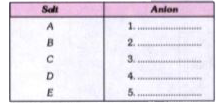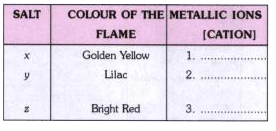Complete Solutions to Additional Questions for Practice of chapter PRACTICAL CHEMISTRY of Class 10 book with complete answers and questions
| Class 10 | CHEMISTRY |
| Chapter | PRACTICAL CHEMISTRY |
| EVERGREEN PUBLICATION | Additional Questions for Practice |
| Number Of Questions | 23 |
| Academic Year | 2023-24 |
Salts A, B, C, D and E undergo reactions (i) to (v) respectively. Identify the anion present in these salts on the basis of these reactions. Tabulate your answers in the format given below:
(i) When silver nitrate solution is added to a solution of A, a white precipitate, insoluble in dilute nitric acid, is formed.
(ii) Addition of dilute hydrochloric acid to B produces a gas which turns lead acetate paper black.
(iii) When a freshly prepared solution of ferrous sulphate is added to a solution of C and concentrated sulphuric acid is gently poured from the side of the test-tube, a brown ring is formed.
(iv) When dilute sulphuric acid is added to D a gas is produced which turns acidified potassium dichromate solution from orange to green.
(v) Addition of dilute hydrochloric acid to E produces an effervescence. The gas produced turns lime water milky but does not affect acidified potassium dichromate solution.

View SolutionSalts P, Q,R,S,T,U and V undergo reactions (i) to (vii) respectively. Identify the cation present in these salts on the basis of these reactions. Tabulate your answer in the formate given below.
(i) When the salt Pis heated with sodium hydroxide solution a vigorous reaction takes place and a colourless gas is evolved with a pungent and suffocating smell that brings tears in our eyes. The evolved gas gives dense white fumes with a moist glass rod depped with hydrochloric acid.
(ii) Addition of sodium hydroxide solution to a solution of salt Q gives a thick white precipitae which is soluble in excess of sodium hydroxide solution to form a clear solution.
(iii) Addition of ammonium hydroxide solution to a solution of salt R gives a dark blue precipitate which is soluble is excess of ammonium hydroxide solution to form an intense deep blue solution.
(iv) Addition of ammonium hydroxide solution to a solution of 5 gives a dirty green [bottle green] precipitate which is insoluble even in the excess of ammonium hydroxide solution.
(v) Addition of ammonium hydroxide solution to a solution of T gives a reddish brown (rust precipitate] precipitate which is insoluble even in the excess of ammonium hydroxide solution.
(vi) Addition of ammonium hydroxide solution to a solution of V gives a geletaneous white precipitate which is soluble in excess of ammonium hydroxide solution to form a clear solution.
(vii) Addition of ammonium hydroxide solution to a solution of V gives no precipitate but it gives a chalky white precipitate with sodium hydroxide solution which is insoluble even in the excess of sodium hydroxide solution.

View SolutionSalts K, L, M, N and O undergo reaction (i) to (v) respectively with different reagents given below. Identify the cation present in these salts on the basis of these reaction. Tabulate your answer in the format given below:
(i) Addition of potassium chromate solution to a solution of salt K gives a golden yellow precipitate.
(ii) Addition of potassium ferrocyanide solution to a solution of slat L gives a chocolate brown precipitate.
(iii) Addition of potassium ferricyanide solution to a solution of salt M gives an intese deep blue solution.
(iv) Addition of potassium ferrocyanide solution to a solution of O gives a bluish white precipitate.

View SolutionHow will you distinguish between the following pairs of gases:
Sulphur dioxide and Ammonia.
View SolutionHow will you distinguish between the following pairs of gases:
Hydrogen sulphide and Hydrogen chloride.
View SolutionHow will you distinguish between the following pairs of gases:
Hydrogen chloride and Nitrogen dioxide.
View SolutionHow will you distinguish between the following pairs of gases:
Hydrogen and Oxygen.
View SolutionThe metallic ions (the cations) can be identify by performing flame test which is describe below.
"Make a paste of the given salt in concentrated hydrochloric acid. Load the paste on a clean platinum wire and introduce it in a non-luminous bunsen burner flame. Note the colour of the flame imparted by the flame. Tabulate your answer in the formate given below. The salt x imparts golden yellow flame. The salt y imparts lilac flame and the salt z imparts bright red flame.

View SolutionMatch the following:

View SolutionDescribe all that you would observe when the following compounds are heated.
Lead nitrate.
View SolutionDescribe all that you would observe when the following compounds are heated.
Zinc carbonate.
View SolutionDescribe all that you would observe when the following compounds are heated.
Copper carbonate.
View SolutionDescribe all that you would observe when the following compounds are heated.
Lead nitrate crystals
View SolutionDescribe all that you would observe when the following compounds are heated.
Mercuric oxide.
View SolutionDescribe all that you would observe when the following compounds are heated.
Ammonium chloride.
View SolutionDescribe all that you would observe when the following compounds are heated.
Ammonium dichromate.
View SolutionWhat happens when ammonium hydroxide and sodium hydroxide solutions are added one by one in turns to the solutions of:
Silver nitrate.
View SolutionWhat happens when ammonium hydroxide and sodium hydroxide solutions are added one by one in turns to the solutions of :
Lead nitrate.
View SolutionWhat happens when ammonium hydroxide and sodium hydroxide solutions are added one by one in turns to the solutions of :
Copper nitrate.
View SolutionWhat happens when ammonium hydroxide and sodium hydroxide solutions are added one by one in turns to the solutions of :
Zinc nitrate.
View SolutionWhat happens when ammonium hydroxide and sodium hydroxide solutions are added one by one in turns to the solutions of :
Calcium nitrate.
View SolutionWhat happens when ammonium hydroxide and sodium hydroxide solutions are added one by one in turns to the solutions of :
Ammonium chloride
View SolutionWhat happens when ammonium hydroxide and sodium hydroxide solutions are added one by one in turns to the solutions of :
Ammonium dichromate.
View Solution
Additional Questions for Practice questions and complete solutions for chapter PRACTICAL CHEMISTRY of EVERGREEN CHEMISTRY (ENGLISH) of Class 10
All Exercises from EVERGREEN PUBLICATION Class 10 CHEMISTRY PRACTICAL CHEMISTRY
- Additional Questions
- Additional Questions for Practice
- QUESTIONS
- Questions from Previous ICSE Board Papers (2007)
- Questions from Previous ICSE Board Papers (2008)
- Questions from Previous ICSE Board Papers (2009)
- Questions from Previous ICSE Board Papers (2010)
- Questions from Previous ICSE Board Papers (2012)
- Questions from Previous ICSE Board Papers (2013)
- Questions from Previous ICSE Board Papers (2014)
- Questions from Previous ICSE Board Papers (2015)
- Questions from Previous ICSE Board Papers (2016)
- Questions from Previous ICSE Board Papers (2017)
- UNIT TEST PAPER - Chemistry Practicals
- WORKSHEET
- WORKSHEET (Give one word for the following)
- WORKSHEET (Tick the correct options)